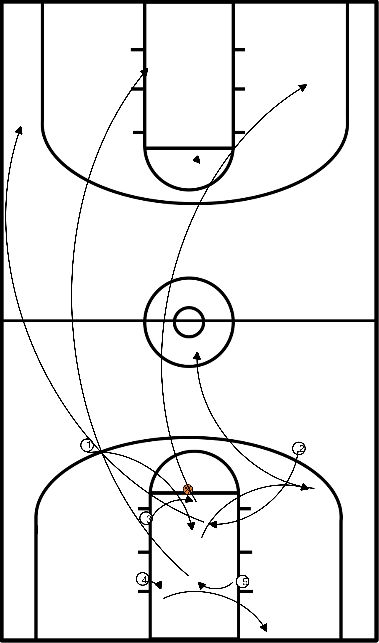Basketball drills for technique dribbling
Dribble:
- first good hand
- other hand
- in turn
- take high
- take low
- walk dribble
- go under your leg
5 players are ready at the free throw line coach stands at the free throw line
after the shot, the 4 catches the ball (hit or not) and takes it out on the other side of the board.
- 1 crosses by the shooter and gets the ball
- 2 is already running away
- 5 is already walking towards the post
- 3 runs to other wing, and gets pass from 1 with hard dribble to the ring.
After each action 2, 4 and 5 run in for rebound. 4 takes ball out again, 1 runs on line.
- First action is 4 takes ball out, and passes to 1, who dribbles to center and passes to 2 who goes with 1 hard dribble to the ring.
- Next action is pass 4 -> 1 -> 2 -> 5 into post for action under basket
- Next action is pass 4 -> 1 -> 3 -> 1 for shot on top
- Next action is pass 4 -> 1 -> 2 -> 4 in the high post trailer
- Last action is long pass from 4 to 3 for the last minute shot/layup.

- dribble ring
- different direction changes
- Finish at choice
- 2 sides off the court.
- Leftside/right hand lay-up.
- Dribble to pilon. Dribble backwards.
- Dribble to pilon 2.
- Twice between the legs.
- Dribble to pilon 3.
- Pivot to right hand and finish with a lay-up front basket.
- Rebound your own ball.
- Rightside/left hand lay up.
- Dribble to pilon 1.
- Crossover twice.
- Dribble to pilon 2.
- Behind the back (left and/or right).
- Dribble to pilon 3.
- Jumpstop.
- Big step with inside leg to the basket.
- 1 ball per player.
- Row A, half number of players.
- Left side ashes half.
- Pawn at three-point line on left side of field.
- Spindribble right, coming out on top of bucket set or jumpshot.
- Finish with jump stop, around your man (pawn), right hand without board from in front of the basket.
- Row B, half number of players.
- Right side of the field.
- 1st pawn cross dribble left/right, 2nd pawn reverse dribble, 3rd pawn 2x through legs.
- One on one till midcourt average speed.
- Goal: Slides defender.
- From 1m over midcourt.
- One on ne to the basket. 1 shot.
- Score by offense, offense stays offense
- First to 4.
- Row A, half number of players. Left side axis half.
- Pawn at three-point line on left side of field. Spindribble right, coming out at head of bucket set or jumpshot.
- Finish with jump stop, around your man (pawn), right hand without board from in front of the basket.
- Row B, half number of players. Right side of the court.
- 1st pawn cross dribble left/right, 2nd pawn reverse dribble, 3rd pawn 2x through legs.
- The players give each other difficult balls.
- Throwing in such a way that one has to make an effort to catch with one hand.
- At knee height, slightly past the body, slightly above the head.
- Halfway through the normal dribbling height, the ball is brought to the other dribbling hand with a wrist strike via a flat bounce.
- At the moment the movement is started, the right leg steps forward,
- so that the ball can reach the left hand unimpeded.
- The ball passes in front of the left foot.
- The ball is taken low with the other hand.
- After the takeover the body turns over the left foot between the ball and the defender,
- where the free (bent) arm again has a protective function.
- In the speed dribble, the upper body makes an angle of less than 90 degrees with the ground.
- This is highly dependent on the speed at which the dribble is performed. The higher the speed, the smaller the angle.
- The dribbling arm is directed more forward due to the speed.
- The dribble is between hip and chest height; the ball is pushed powerfully to the ground and lands next to the shoulder axis in front of the feet.
- If there are no defenders around, the free arm has a balancing function
- If this is not the case, the dribbler will initially try to increase his speed in order to shake off the defender
- If this does not work, he can use his free arm to prevent the opponent from taking the ball.
- Obviously, this will be at the expense of speed.
- The walking speed must be in accordance with the dribbler's level; walking and dribbling must not hinder each other.
- The knees and ankles are bent strongly during the low dribble, allowing the ball to stay extra low to the ground.
- The torso and head, on the other hand, remain practically straight.
- The gaze is directed towards the opponent(s) and the rest of the field of play
- The free (slightly bent) arm is turned towards the opponent and has a protective function.
- If the situation requires, the body is brought between the opponent and the ball.
- Bringing the ball up to the attacking half.
- Fast break.
- When the way to the basket is clear.
- One-on-one situations.
- Drive, between defenders.
- Freeing up to get into a better shot position or passing opportunity.
- Escape from a situation where passing is simply not possible and the ball must be protected.







